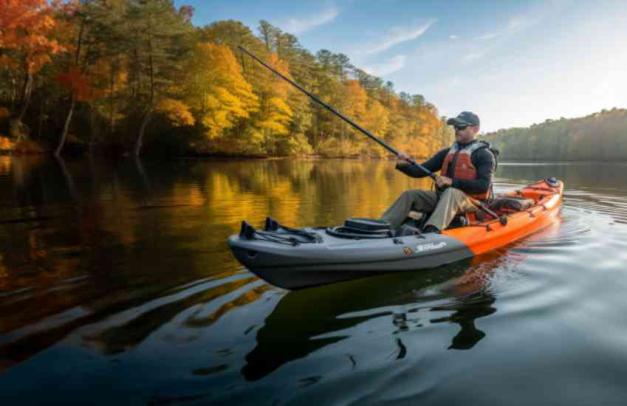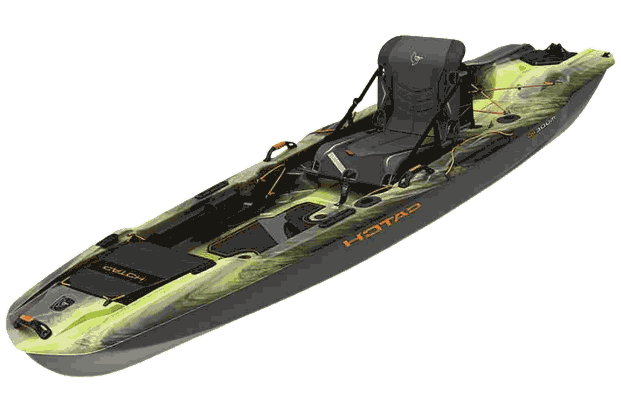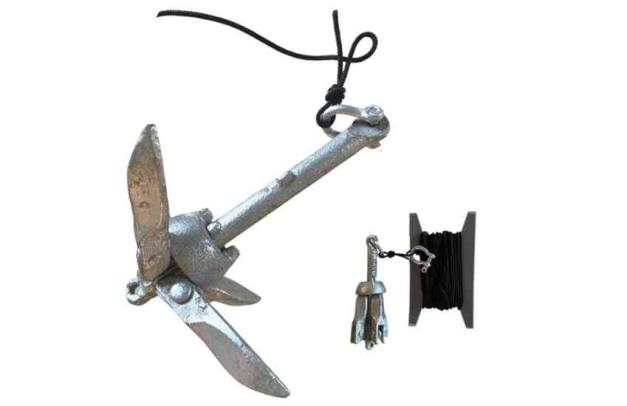1.3 Mastering the Basics: Choosing the Perfect Fishing Kayak
Understanding Kayaks for Fishing

Hey there, fellow anglers!When it comes to kayak fishing, one of the most crucial aspects that can significantly impact your experience is the choice of fishing kayak. As an experienced writer and teacher in the realm of outdoor activities, I’ve had my fair share of encounters with various types of fishing kayaks, each presenting its own set of advantages and challenges.
In this section, I’ll share my insights and experiences regarding different types of fishing kayaks, factors to consider when selecting one, and essential accessories and modifications to outfit your kayak for the ultimate fishing adventure.
So, gear up, because we’re about to explore the ins and outs of kayaks for fishing like never before!
After Completing This Article, You Will Learn:
- The different types of fishing kayaks and their advantages and disadvantages.
- Key factors to consider when selecting a fishing kayak that suits your needs.
- Essential accessories and modifications to outfit your kayak for fishing.
- How to ensure safety and comfort while fishing from a kayak.
- The importance of proper kayak maintenance for optimal performance.
Understanding Kayaks for Fishing
Navigating the waters in a fishing kayak adds a unique dimension to your angling pursuits. But not all kayaks are created equal when it comes to fishing. There are several types of fishing kayaks available, each with its distinct features and benefits.
Sit-On-Top, Sit-Inside, Inflatable & Pedal-Driven Kayaks

In my journey as an angler, I’ve had the chance to fish from various types of kayaks, and each type offers its own advantages. Sit-on-top kayaks are incredibly popular for fishing due to their open design, which provides excellent stability and ease of movement. These kayaks are particularly well-suited for beginners and those who prefer a more relaxed fishing experience. I vividly recall fishing from a sit-on-top kayak during a serene sunset, appreciating the comfort and freedom it offered.

Sit-inside kayaks, on the other hand, offer more protection from the elements and can be suitable for cooler weather or rougher waters. Their enclosed cockpit can provide a sense of security and allow for efficient use of space. I once found myself in unpredictable weather conditions during a fishing expedition, and the sit-inside kayak I was using provided a shield from the wind and splashing waves.

Inflatable kayaks have gained popularity due to their portability and ease of storage. While they may not be as rigid as hard-shell kayaks, modern inflatable models are remarkably durable and can offer a convenient option for anglers who don’t have ample storage space. I once embarked on a fishing trip to a remote location that required a long hike, and an inflatable kayak proved to be a game-changer in terms of transportability.

Pedal-driven kayaks have revolutionized the fishing experience by allowing anglers to propel themselves using pedals instead of traditional paddles. These kayaks provide hands-free operation, enabling better control while fishing and casting. During a particularly windy day when paddling was a challenge, I found that using a pedal-driven kayak allowed me to maintain my position effortlessly, enhancing my ability to target specific spots effectively.
Factors to Consider When Choosing a Fishing Kayak
In my years of teaching and writing about kayak fishing, I’ve emphasized the importance of considering various factors before investing in a fishing kayak. One size does not fit all, and your choice should align with your fishing style, preferred water environments, and personal preferences.
Stability and Weight Capacity: Stability is key for kayak fishing, especially when casting, reeling, and handling your catch. I recall my initial attempts at casting from an unstable kayak, which led to frustration and lost opportunities. Opt for a kayak with a stable hull design and an appropriate weight capacity to accommodate you and your fishing gear.
Size and Maneuverability: Consider the size of the kayak in relation to the waters you intend to fish. Smaller kayaks can be advantageous for navigating tight spaces, while larger kayaks offer more storage capacity. During a fishing trip on a narrow river with plenty of twists and turns, a compact kayak allowed me to access areas that larger vessels couldn’t reach.
Transport and Storage: If you have limited storage space or plan to transport your kayak frequently, the size and weight of the kayak become crucial. I’ve faced the challenge of storing multiple kayaks in my garage, and opting for inflatable kayaks provided a practical solution without compromising on performance.
Seating and Comfort: Comfort is paramount during extended fishing sessions. A comfortable, adjustable seat can make a significant difference in your overall experience. I recall a full day of fishing on a lake, and the ergonomic seating of my kayak allowed me to remain focused on fishing without discomfort.
Accessories and Modifications
Once you’ve selected the right fishing kayak, it’s time to tailor it to your specific angling needs. Accessories and modifications play a pivotal role in enhancing your fishing efficiency and comfort.

Fishing Rod Holders: Installing fishing rod holders on your kayak can free up your hands for other tasks while keeping your rods secure. I’ve customized my kayaks with adjustable rod holders strategically placed within arm’s reach, allowing for quick access to my rods when a fish strikes.

Anchor System: An anchor system can be a game-changer when you need to stay in a specific spot, whether it’s to target a productive fishing area or to cast multiple times to a promising structure. I’ve had moments when a gentle breeze threatened to move me away from a prime fishing location, but an anchor system provided the solution by keeping me anchored in place.
Fish Finders and Electronics: Equipping your kayak with fish finders and GPS devices can give you a competitive edge by helping you locate fish and underwater structures. I recall a time when I struggled to find fish in a vast lake, but the fish finder allowed me to identify underwater contours and hotspots, ultimately leading to a successful day of fishing.
Storage Solutions: Adequate storage is essential for keeping your fishing gear organized and accessible. I’ve utilized kayak crates, dry bags, and gear tracks to create efficient storage solutions that accommodate tackle boxes, snacks, and other essentials.
Final Word
In this section, you have learned about the different types of kayaks that are available for fishing, and how to choose the best one for your needs. You have discovered the pros and cons of sit-on-top, sit-inside, inflatable, and pedal-driven kayaks, and how they suit different fishing styles and environments.
As an experienced angler and writer, I’ve had the privilege of exploring various types of fishing kayaks and fine-tuning my approach to outfitting them for optimal performance. By considering factors such as kayak type, stability, maneuverability, and personal preferences, you can choose a kayak that suits your fishing style and environment. Moreover, accessories and modifications, including rod holders, anchor systems, and electronics, should enhance your kayak fishing experience by increasing efficiency and convenience on the water.
So, whether you’re casting in serene lakes or challenging river currents, a well-selected and customized fishing kayak can be your trusty companion in the pursuit of memorable angling adventures.
Are you ready to learn more about the gear and safety precautions that you need to take when kayak fishing? In the next section, you will learn about the fishing equipment that you need to bring on your kayak, such as rods, reels, lines, leaders, and knots.
You will also learn about the must-have kayak fishing gear that will help you tackle the elements, such as personal flotation devices (PFDs), safety whistles, paddles, anchors, paddle leashes, clothing, and sun protection. Furthermore, you will learn how to stay safe on the water by following basic water safety tips, handling wind, waves, and currents effectively, performing self-rescue techniques, and dealing with emergencies. Stay tuned!
Sit-On-Top Kayaks

Sit-on-top kayaks are a popular choice for fishing due to their open design. These kayaks have a molded seat on top of the hull, allowing anglers to sit in an elevated position, which provides better visibility and ease of movement. Sit-on-top kayaks are stable and user-friendly, making them ideal for beginners and anglers who prefer an easy-to-use fishing platform. Additionally, these kayaks have scupper holes, which allow water to drain out, ensuring you stay dry even in choppy conditions.
Sit-Inside Kayaks

Sit-inside kayaks, also known as “sit-in” kayaks, feature an enclosed cockpit where the paddler sits inside the kayak with their legs positioned beneath the deck. While these kayaks offer better protection from water and weather, they are less commonly used for fishing due to their limited space and reduced stability compared to sit-on-top kayaks. However, some anglers prefer sit-inside kayaks for fishing in cold weather or rough waters, as they provide added protection and can be fitted with spray skirts.
Inflatable Fishing Kayaks

Inflatable kayaks have gained popularity among kayak anglers for their portability and ease of storage. These kayaks are made from durable, puncture-resistant materials and can be inflated and deflated quickly. Inflatable fishing kayaks come in both sit-on-top and sit-inside designs, providing versatility for various fishing conditions. While they may not offer the same level of performance as hardshell kayaks, inflatable models are an excellent option for anglers who have limited storage space or travel frequently to different fishing destinations.
Pedal-Driven Fishing Kayaks

Pedal-driven fishing kayaks, also known as pedal kayaks, are designed with foot-operated propulsion systems. Instead of using a paddle, anglers can pedal the kayak using their legs, leaving their hands free to focus on fishing. This hands-free approach allows for more precise boat positioning and casting while fishing. Pedal kayaks are especially popular among anglers who fish in windy conditions or need to cover long distances efficiently.
Factors to Consider When Choosing a Fishing Kayak
Selecting the right fishing kayak is essential for a successful and enjoyable experience on the water. Here are some factors to consider before making your purchase:
Fishing Environment
Consider the primary fishing environment you’ll be exploring. If you plan to fish in calm lakes and slow-moving rivers, a stable and maneuverable kayak would be suitable. For anglers who enjoy tackling coastal waters and larger bodies of water, a more streamlined and efficient kayak with good tracking capabilities is preferable.
Stability and Comfort
Stability is a critical factor, especially for anglers who stand while fishing or need to handle gear and tackle on the kayak. A stable kayak will provide a secure platform, allowing you to focus on your fishing without worrying about tipping over. Additionally, comfortable seating and ample legroom are essential for long fishing sessions.
Weight Capacity and Storage
Consider the weight capacity of the kayak and the amount of gear you plan to bring along. Fishing kayaks with higher weight capacities will be able to accommodate more gear and supplies for longer fishing trips. Look for kayaks with ample storage options, including hatches and bungee cords, to keep your equipment organized and accessible.
Transportation and Storage
If you have limited space for storage or transportation, consider the size and weight of the kayak. Inflatable kayaks are an excellent option for anglers with limited storage space, as they can be deflated and easily stored in a compact bag. Additionally, some hardshell kayaks are designed with features like retractable handles and lightweight materials, making them easier to transport.
Customization Options
Check for fishing-specific features and customization options on the kayak. Some fishing kayaks come with built-in rod holders, tackle storage compartments, and accessory mounts for installing fish finders or other electronics. Customization allows you to tailor your kayak to suit your unique fishing style and needs.
Test Before Buying
Whenever possible, try out the kayak before making a purchase. Many kayak retailers offer demo days or rental options, allowing you to test different models on the water to see which one best suit your preferences and paddling style.
Outfitting Your Kayak for Fishing: Essential Accessories & Modifications
Once you have chosen the right fishing kayak, outfitting it with essential accessories and modifications can greatly enhance your fishing experience. Here are some key accessories to consider:
Fishing Rod Holders

Rod holders are essential for keeping your fishing rods secure and accessible while on the water. Depending on your fishing style, consider different types of rod holders, such as flush-mounted, adjustable, or swivel rod holders. Many kayaks come with pre-installed rod holders, but you can also add aftermarket holders for more customization.
Tackle Storage Solutions
Keep your tackle organized and within reach with tackle storage solutions. Tackle boxes or bags with multiple compartments can help you sort and carry various lures, baits, and fishing accessories. Additionally, some kayaks have integrated tackle storage areas for added convenience.
Anchors and Anchor Trolleys
An anchor is essential for staying in while fishing a specific spot. Anchor trolleys allow you to position your anchor from the bow to the stern, adjusting your kayak’s orientation without the need to reposition the anchor physically. This feature is particularly useful for anglers who want to fish a specific area thoroughly.
Electronics and Fish Finders
Fish finders are valuable tools for locating fish and understanding the underwater environment. Modern fish finders come with advanced features such as GPS mapping, depth sensing, and structure imaging, which can significantly improve your fishing success. Install a fish finder mount on your kayak to keep your electronics secure and easily viewable.
Kayak Carts and Carriers

Transporting your kayak from your vehicle to the water can be challenging, especially if you have a heavy fishing kayak. Kayak carts and carriers are designed to make the process easier by allowing you to wheel or carry your kayak with greater convenience.
Personal Flotation Devices (PFDs)
Safety should always be a top priority when kayaking. Invest in a comfortable and Coast Guard-approved personal flotation device (PFD) that fits properly and provides adequate buoyancy. Choose a PFD designed for paddling or kayak fishing, as these offer greater mobility and comfort while on the water.
Safety Precautions
Before venturing out on your kayak fishing excursions, it’s essential to be familiar with basic water safety and kayak handling. Here are some safety precautions to keep in mind:
Learn Basic Kayak Handling Skills
If you’re new to kayaking, take some time to learn basic paddling techniques and kayak maneuvers. Practice in calm waters to build your confidence and improve your kayak control. Understanding how to turn, stop, and navigate efficiently will contribute to a safe and enjoyable fishing experience.
Wear a Personal Flotation Device (PFD)
Always wear a properly fitting PFD while on the water. Even if you are a strong swimmer, unexpected situations can arise, and a PFD can save your life. Make sure the PFD is securely fastened and comfortable, allowing you to move freely while fishing.
Check Weather and Water Conditions
Before heading out, check the weather forecast and water conditions. Avoid kayaking in adverse weather conditions, such as strong winds, thunderstorms, or high waves. Be aware of potential changes in weather and plan your trip accordingly.
Inform Someone About Your Trip
Always inform someone you trust about your kayak fishing plans, including your intended route and estimated return time. This way, if any emergencies arise, someone will know to check on your well-being.
Stay Hydrated and Protected from the Sun
Bring an adequate supply of water to stay hydrated during your fishing trip. Additionally, protect yourself from the sun’s harmful rays by wearing sunscreen, sunglasses, and appropriate clothing. Sunburn and dehydration can be significant safety concerns, especially during long days or long times on the water.
Be Mindful of Water Traffic
Pay attention to other watercraft and boaters while kayaking. Stay clear of larger vessels and be aware of your surroundings to avoid potential collisions.
Final Word
In this section, you have learned about the different types of kayaks that are available for fishing, and how to choose the best one for your needs. You have discovered the pros and cons of sit-on-top, sit-inside, inflatable, and pedal-driven kayaks, and how they suit different fishing styles and environments.
You have also learned about the factors to consider when choosing a fishing kayak, such as size, stability, maneuverability, storage, and comfort. Moreover, you have learned how to outfit your kayak for fishing, with essential accessories and modifications that will enhance your fishing performance and experience.
By now, you have a clear idea of what kind of kayak you want to use for fishing, and how to customize it to your preferences.
Are you ready to learn more about the gear and safety precautions that you need to take when kayak fishing? In the next section, you will learn about the fishing equipment that you need to bring on your kayak, such as rods, reels, lines, leaders, and knots.
You will also learn about the must-have kayak fishing gear that will help you tackle the elements, such as personal flotation devices (PFDs), safety whistles, paddles, anchors, paddle leashes, clothing, and sun protection. Furthermore, you will learn how to stay safe on the water by following basic water safety tips, handling wind, waves, and currents effectively, performing self-rescue techniques, and dealing with emergencies. Stay tuned!